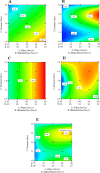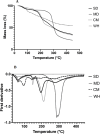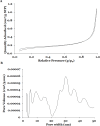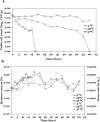Encapsulation improves viability and stability of spray-dried Lactococcus lactis A12 for inclusion in fish feed
- PMID: 40424401
- PMCID: PMC12112376
- DOI: 10.1371/journal.pone.0323000
Encapsulation improves viability and stability of spray-dried Lactococcus lactis A12 for inclusion in fish feed
Abstract
During probiotics manufacturing, drying is a crucial process for stabilization of probiotics after fermentation, since drying condition could affect viability and functionality as well as physical properties such as moisture content and water activity, which play key role in stability of dried probiotics during storage. Therefore, this study aimed to evaluate the effect of spray-drying parameters on the survival of Lactococcus lactis A12 after drying and exposure to gastrointestinal conditions. A combined mixture-process design was carried out by evaluating three factors: whey (10-30% w/v), maltodextrin (10-30% w/v), and atomization pressure (1.0-1.5 bar). As the main results, a high concentration of whey (30% w/v), low concentration of maltodextrin (10% w/v), and high atomization pressure (1.4 bar) improved survival of spray-dried L. lactis A12 after drying and exposure to pH 3.00 or bile salts with survival rates ranged within 69.25 to 86.24%, 65.89-98.93%, and 89.09-100%, respectively. Under optimal conditions, spray-dried probiotic powder with wall materials (encapsulated) exhibited higher glass transition temperature (64.44 vs 12.65 °C), and lower hygroscopicity (12.65 vs 64.44%) than spray-dried probiotic without wall materials (non-encapsulated). Moreover, SD probiotic powder exhibited the highest survival rate (85.88%) at 4 °C during 60 days of storage in comparison to 25 °C and 37 °C which did not survive. Finally, spray-dried L. lactis A12 was included in fish feed and exhibited a survival rate of 80.83% when it was stored at 4 °C after 60 days. It can be concluded that the use of encapsulating materials, particularly whey and maltodextrin, improved the physical and thermal stability of L. lactis A12 powder during drying and storage. Also, the results from the stability of supplemented fish feed suggested that L. lactis A12 could be included in fish feed.
Copyright: © 2025 Valle Vargas et al. This is an open access article distributed under the terms of the Creative Commons Attribution License, which permits unrestricted use, distribution, and reproduction in any medium, provided the original author and source are credited.
Conflict of interest statement
The authors have declared that no competing interests exist.
Figures








Similar articles
-
Microencapsulation of Lactobacillus rhamnosus ATCC 7469 by spray drying using maltodextrin, whey protein concentrate and trehalose.Food Sci Technol Int. 2022 Sep;28(6):476-488. doi: 10.1177/10820132211020621. Epub 2021 May 31. Food Sci Technol Int. 2022. PMID: 34058894
-
Comparative survival of probiotic lactobacilli spray-dried in the presence of prebiotic substances.J Appl Microbiol. 2004;96(5):1024-39. doi: 10.1111/j.1365-2672.2004.02219.x. J Appl Microbiol. 2004. PMID: 15078519
-
Can operational parameters impact spray-dried bacteria viability and production costs? An experimental study with autochthonous Lactococcus lactis subsp. lactis isolated from Amazonian artisanal cheese.Food Res Int. 2025 Feb;202:115725. doi: 10.1016/j.foodres.2025.115725. Epub 2025 Jan 10. Food Res Int. 2025. PMID: 39967101
-
Improving the drying of Propionibacterium freudenreichii starter cultures.Appl Microbiol Biotechnol. 2021 May;105(9):3485-3494. doi: 10.1007/s00253-021-11273-3. Epub 2021 Apr 22. Appl Microbiol Biotechnol. 2021. PMID: 33885925 Review.
-
Optimization of spray drying process parameters for the food bioactive ingredients.Crit Rev Food Sci Nutr. 2024;64(17):5631-5671. doi: 10.1080/10408398.2022.2156976. Epub 2022 Dec 22. Crit Rev Food Sci Nutr. 2024. PMID: 36547397 Review.
References
-
- FAO. The State of World Fisheries and Aquaculture 2020. Rome, Italy: FAO; 2020. Jun. doi: 10.4060/ca9229en - DOI
-
- FAO. The State of World Fisheries and Aquaculture 2024. Rome: FAO; 2024. doi: 10.4060/cd0683en - DOI
-
- del Valle JC, Bonadero MC, Fernández-Gimenez AV. Saccharomyces cerevisiae as probiotic, prebiotic, synbiotic, postbiotics and parabiotics in aquaculture: an overview. Aquaculture. 2023;569:739342. doi: 10.1016/j.aquaculture.2023.739342 - DOI
MeSH terms
Substances
LinkOut - more resources
Full Text Sources
Research Materials

